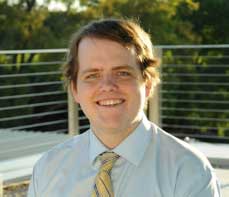Outreach: A Graduate Student’s Perspective
By Rachel Henderson
Seth Kimbrell is halfway through his second year of graduate school at Montana State University (MSU). Seth’s research interests lie in observational astronomy and the search for black holes within dwarf galaxies. As an undergraduate at Georgia Tech, he worked on several different projects (including examining the electrical activity in the muscles of cockroaches as they run!) before finding a spot in a lab doing data analysis for gravitational wave astronomy.

What experiences do you or your University have involving physics/astronomy outreach?
As an undergraduate, I was a host of a summer program called Physics of Roller Coasters. In this program, middle schoolers and high schoolers spent a week at Georgia Tech learning the physics behind thrill rides, including the science behind stopping safely and why roller coaster loops aren’t perfectly round. Now as a graduate student at MSU, I am the graduate student manager of the Space Public Outreach Team (SPOT). SPOT is a program underneath the Montana Space Grant Consortium; we are funded by NASA to train undergraduates to travel across Montana giving presentations to young students about NASA missions and the wonders of science. Our show this year is about Jupiter, and includes some of the latest and greatest images being sent back by the Juno spacecraft, which is currently orbiting Jupiter.
How did you get involved in outreach?
Outreach and education has really always been a passion of mine, going all the way back to recording commercials to encourage recycling for my high school’s morning news show. As a Sophomore at Georgia Tech, I and many others participated in the Atlanta Science Festival, during which we presented a particle detector and taught the basics of what the detector did to children and adults alike. Since then, I always knew that I wanted to continue in science outreach and increase science awareness.
During the summer between my first and second years at MSU, I was asked to be the graduate student manager for SPOT and was thrilled to jump on board. Since then, I have talked about Jupiter with elementary schoolers and high schoolers, and I have enjoyed every second of it! We also have undergraduates at MSU and at the University of Montana (UM) who are trained to give the show and continue to participate in outreach events like the Great Falls STEAM (Science, Technology, Engineering, Art and Mathematics) Festival and the Museum of the Rockies Science Night.
What is your favorite part of participating in outreach events?
My favorite part of participating in outreach events is the look on a young child’s face when they learn something super interesting about space and get excited about it. My birthday falls during the Perseid Meteor Shower, so when I was a child my parents would drive me out into the countryside of Georgia and we would watch the meteors fall. Watching those shooting stars made me want to know more about why they were there, and how we knew about them so far in advance, which led to me pursuing physics as a career. Knowing that my outreach could be the same kind of catalyst for a young child keeps me excited to do outreach and makes me want to make science as interesting for students as I can.
As a graduate student, how can the APS Forum on Outreach and Engaging the Public (FOEP) help you become successful with your efforts in physics/astronomy outreach?
I think that the biggest help that the APS FOEP provides me is all the tips and tricks they provide on their website for outreach. I am always happy when an idea gets brought up or I read some new tip and it gives me some new perspective on outreach that I hadn’t thought of before. Exchanging ideas and information is such a great resource, and it definitely contributes to me being better and bringing the world of physics and astronomy to younger audiences.
Stay tuned for more perspectives on outreach from other Physics & Astronomy Graduate Students!

30 second exposure, Friday, Aug. 12, 2016 in Spruce Knob, West Virginia. Image Credit: NASA/Bill Ingalls (https://www.nasa.gov/image-feature/perseid-meteor-shower-2016-from-west-virginia)
